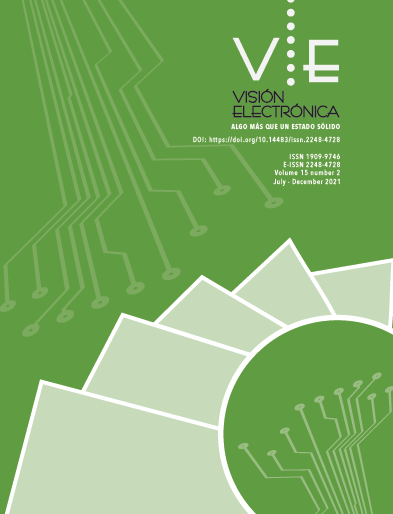Published:
2023-01-30Issue:
Vol. 17 No. 1 (2023)Section:
A Research VisionEvolución del uso de nanopartículas en diagnóstico y tratamiento del cáncer
Evolution of the use of nanoparticles in cancer diagnosis and treatment
Keywords:
Fluido biomagnético, Nanopartículas, Nanopártículas magnéticas, SPIONs (es).Keywords:
Biomagnetic fluid, Nanoparticles, Magnetic nanoparticles, SPIONs (en).Downloads
Abstract (es)
El uso de nanopartículas en el área de la salud es un tema de investigación que ha venido incrementándose en los últimos años, desde esa perspectiva este trabajo se centró en hacer una caracterización de las nanopartículas, su evolución e interacción con la sangre, aspecto abordado a través de la descripción del fluido biomagnético, centrándonos en características como viscosidad y la geometría. También, se da a conocer la evolución de las aplicaciones o técnicas en las cuales se han venido empleando las nanopartículas, enfocando la revisión realizada en tratamientos contra el cáncer, para lo cual se consideraron las cuatro generaciones progresivas de este campo investigativo, así como el uso de las nanopartículas en imágenes diagnósticas. Finalmente se identificaron algunos campos de implementación y estudio en Colombia. La revisión realizada permite concluir que la evolución del empleo de las nanopartículas en aplicaciones médicas ha posibilitado la realización de tratamientos de cáncer focalizados; en ese sentido se reconoce la incidencia de los SPIONs en los avances logrados recientemente, así como la importancia de profundizar en el estudio del movimiento de estas partículas.
Abstract (en)
The use of nanoparticles in the health area is a research topic that has been increasing in recent years, from that perspective this work focused on making a characterization of nanoparticles, their evolution and interaction with blood, aspect addressed through the description of the biomagnetic fluid, focusing on characteristics such as viscosity and geometry. Also, the evolution of the applications or techniques in which nanoparticles have been used is presented, focusing the review on cancer treatments, for which the four progressive generations of this research field were considered, as well as the use of nanoparticles in diagnostic imaging. Finally, some fields of implementation and study in Colombia were identified. The review carried out allows concluding that the evolution of the use of nanoparticles in medical applications has made possible the realization of targeted cancer treatments; in this sense, the incidence of SPIONs in the advances achieved recently is recognized, as well as the importance of deepening the study of the movement of these particles.
References
Y. Rojas, K. Aguado, and I. González, “La nanomedicina y los sistemas de liberación de fármacos: ¿la (r)evolución de la terapia contra el cáncer?,” Educ. Quim., vol. 27, no. 4, pp. 286–291, 2016.
R. R. Wakaskar, “General overview of lipid–polymer hybrid nanoparticles, dendrimers, micelles, liposomes, spongosomes and cubosomes,” J. Drug Target., vol. 26, no. 4, pp. 311–318, 2018.
B. Alfonso and C. Casado, “DENDRÍMEROS: MACROMOLÉCULAS VERSÁTILES CON INTERÉS INTERDISCIPLINAR,” J. Chem. Inf. Model., vol. 01, no. 01, pp. 1689–1699, 2016.
B. Haley and E. Frenkel, “Nanoparticles for drug delivery in cancer treatment,” Urol. Oncol. Semin. Orig. Investig., vol. 26, no. 1, pp. 57–64, 2008.
M. C. Urrejola et al., “Sistemas de Np Poliméricas II: Estructura, Métodos de Elaboración, Características, Propiedades, Biofuncionalización y Tecnologías de Auto-Ensamblaje Capa por Capa (Layer-by-Layer Self-Assembly),” Int. J. Morphol., vol. 36, no. 4, pp. 1463–1471, 2018.
F. Chávez, B. I. Olvera, A. Ganem, and D. Quintanar, “Liberación de sustancias lipofílicas a partir de nanocápsulas poliméricas,” J. Mex. Chem. Soc., vol. 46, no. 4, pp. 349–356, 2002.
Z. M. Avval et al., “Introduction of magnetic and supermagnetic nanoparticles in new approach of targeting drug delivery and cancer therapy application,” Drug Metab. Rev., vol. 52, no. 1, pp. 157–184, 2020.
L. Mohammed, H. G. Gomaa, D. Ragab, and J. Zhu, “Magnetic nanoparticles for environmental and biomedical applications: A review,” Particuology, vol. 30, pp. 1–14, 2017.
A. S. Lübbe et al., “Clinical experiences with magnetic drug targeting: A phase I study with 4’-epidoxorubicin in 14 patients with advanced solid tumors,” Cancer Res., vol. 56, no. 20, pp. 4686–4693, 1996.
H. D. Liu, W. Xu, S. G. Wang, and Z. J. Ke, “Hydrodynamic modeling of ferrofluid flow in magnetic targeting drug delivery,” Appl. Math. Mech. (English Ed., vol. 29, no. 10, pp. 1341–1349, 2008.
G. Zhang et al., “Oxygen-enriched Fe3O4/Gd2O3 nanopeanuts for tumor-targeting MRI and ROS-triggered dual-modal cancer therapy through platinum (IV) prodrugs delivery,” Chem. Eng. J., vol. 388, no. February, p. 124269, 2020.
S. Tong, H. Zhu, and G. Bao, “Magnetic iron oxide nanoparticles for disease detection and therapy,” Mater. Today, vol. 31, no. December, pp. 86–99, 2019.
M. Sosa, J. J. B. Alvarado, and J. L. Gonz, “Tecnicas biomagneticas y su comparacion con los metodos bioelectricos,” vol. 48, no. 5, pp. 490–500, 2002.
S. Bose and M. Banerjee, “Magnetic particle capture for biomagnetic fluid flow in stenosed aortic bifurcation considering particle-fluid coupling,” J. Magn. Magn. Mater., vol. 385, pp. 32–46, 2015.
M. Bartoszek and Z. Drzazga, ; “A study of magnetic anisotropy of blood cells,” vol. 197, pp. 573–575, 1999.
Y. Haik, V. Pai, and C. J. Chen, “Development of magnetic device for cell separation,” J. Magn. Magn. Mater., vol. 194, no. 1, pp. 254–261, 1999.
Z. Liu, Y. Zhu, R. R. Rao, J. R. Clausen, and C. K. Aidun, “Nanoparticle transport in cellular blood flow,” Comput. Fluids, vol. 172, pp. 609–620, 2018.
S. Y. Lee, M. Ferrari, and P. Decuzzi, “Shaping nano-/micro-particles for enhanced vascular interaction in laminar flows,” Nanotechnology, vol. 20, no. 49, 2009.
G. A. Duncan and M. A. Bevan, “Computational design of nanoparticle drug delivery systems for selective targeting,” Nanoscale, vol. 7, no. 37, pp. 15332–15340, 2015.
K. Müller, D. A. Fedosov, and G. Gompper, “Margination of micro- and nano-particles in blood flow and its effect on drug delivery,” Sci. Rep., vol. 4, pp. 1–8, 2014.
Y. Haik, V. Pai, and C. J. Chen, “Apparent viscosity of human blood in a high static magnetic field,” J. Magn. Magn. Mater., vol. 225, no. 1–2, pp. 180–186, 2001.
S. Afkhami and Y. Renardy, “Ferrofluids and magnetically guided superparamagnetic particles in flows: a review of simulations and modeling,” J. Eng. Math., vol. 107, no. 1, pp. 231–251, 2017.
I. Rukshin, J. Mohrenweiser, P. Yue, and S. Afkhami, “Modeling superparamagnetic particles in blood flow for applications in magnetic drug targeting,” Fluids, vol. 2, no. 2, pp. 1–12, 2017.
M. O. Avilés, A. D. Ebner, H. Chen, A. J. Rosengart, M. D. Kaminski, and J. A. Ritter, “Theoretical analysis of a transdermal ferromagnetic implant for retention of magnetic drug carrier particles,” J. Magn. Magn. Mater., vol. 293, no. 1, pp. 605–615, 2005.
A. Hajiaghajani, S. Hashemi, and A. Abdolali, “Adaptable setups for magnetic drug targeting in human muscular arteries: Design and implementation,” J. Magn. Magn. Mater., vol. 438, pp. 173–180, 2017.
V. R. Sharma, A. K. Sharma, V. Punj, and P. Priya, “Recent nanotechnological interventions targeting PI3K/Akt/mTOR pathway: A focus on breast cancer,” Semin. Cancer Biol., vol. 59, no. July 2019, pp. 133–146, 2019.
M. E. Miller, Human Diseases and Yeast.Pdf, First edit. New York: Momentum Press Health, 2018.
A. S. Lübbe, C. Bergemann, W. Huhnt, T. Fricke, and H. Riess, “Lübbe1996_Preclinical,” pp. 4694–4701, 1996.
Lübbe., C. Bergemann, J. Brock, and D. G. McClure, “Physiological aspects in magnetic drug-targeting,” J. Magn. Magn. Mater., vol. 194, no. 1, pp. 149–155, 1999.
C. Alexiou et al., “Locoregional cancer treatment with magnetic drug targeting,” Cancer Res., vol. 60, no. 23, pp. 6641–6648, 2000.
C. Alexiou, A. Schmidt, R. Klein, P. Hulin, C. Bergemann, and W. Arnold, “Magnetic drug targeting: Biodistribution and dependency on magnetic field strength,” J. Magn. Magn. Mater., vol. 252, no. 1-3 SPEC. ISS., pp. 363–366, 2002.
K. Gitter and S. Odenbach, “Experimental investigations on a branched tube model in magnetic drug targeting,” J. Magn. Magn. Mater., vol. 323, no. 10, pp. 1413–1416, 2011.
M. G. Krukemeyer, V. Krenn, M. Jakobs, and W. Wagner, “Mitoxantrone-iron oxide biodistribution in blood, tumor, spleen, and liver - Magnetic nanoparticles in cancer treatment,” J. Surg. Res., vol. 175, no. 1, pp. 35–43, 2012.
M. M. Attar et al., “Thermal analysis of magnetic nanoparticle in alternating magnetic field on human HCT-116 colon cancer cell line,” Int. J. Hyperth., vol. 32, no. 8, pp. 858–867, 2016.
R. Eivazzadeh-Keihan, F. Radinekiyan, A. Maleki, M. Salimi Bani, Z. Hajizadeh, and S. Asgharnasl, “A novel biocompatible core-shell magnetic nanocomposite based on cross-linked chitosan hydrogels for in vitro hyperthermia of cancer therapy,” Int. J. Biol. Macromol., vol. 140, pp. 407–414, 2019.
S. Shabestari Khiabani, M. Farshbaf, A. Akbarzadeh, and S. Davaran, “Magnetic nanoparticles: preparation methods, applications in cancer diagnosis and cancer therapy,” Artif. Cells, Nanomedicine Biotechnol., vol. 45, no. 1, pp. 6–17, 2017.
K. T. Al-Jamal et al., “Magnetic Drug Targeting: Preclinical in Vivo Studies, Mathematical Modeling, and Extrapolation to Humans,” Nano Lett., vol. 16, no. 9, pp. 5652–5660, 2018.
M. Minbashi, A. A. Kordbacheh, A. Ghobadi, and V. V. Tuchin, “Optimization of power used in liver cancer microwave therapy by injection of Magnetic Nanoparticles (MNPs),” Comput. Biol. Med., vol. 120, no. February, p. 103741, 2020.
A. Nan, M. Suciu, I. Ardelean, M. Şenilă, and R. Turcu, “Characterization of the Nuclear Magnetic Resonance Relaxivity of Gadolinium Functionalized Magnetic Nanoparticles,” Anal. Lett., vol. 0, no. 0, pp. 1–16, 2020.
I. Cicha, S. Lyer, C. Alexiou, and C. D. Garlichs, “Nanomedicine in diagnostics and therapy of cardiovascular diseases: Beyond atherosclerotic plaque imaging,” Nanotechnol. Rev., vol. 2, no. 4, pp. 449–472, 2013.
M. Nahrendorf et al., “Nanoparticle PET-CT imaging of macrophages in inflammatory atherosclerosis,” Circulation, vol. 117, no. 3, pp. 379–387, 2008.
S. Jaimes, A. Gonzáles, C. Granados, D. Álvarez, and E. Espitia, “Redalyc.Nanotecnología: avances y expectativas en cirugía,” Rev. Colomb. Cirugía, vol. 27, pp. 158–166, 2012.
B. Méndez and C. Muñoz, “Nanochips y nanosensores para eldiagnóstico temprano de cáncer oral: una revisión,” no. 67, pp. 131–147, 2012.
D. Rodriguez, J. Moyano, and L. Roa, “Estudio por dinámica molecular browniana de np bajo efectos de Bs externos,” Ing. Mil., vol. 13, no. 9, pp. 90–98, 2018.
J. Gallo and C. Ossa, “Fabricación y caracterización de np de plata con potencial uso en el tratamiento del cáncer de piel,” Ing. y Desarro., vol. 37, no. 1, pp. 88–104, 2019.
J. Pantoja, “np magnéticas en flujo sanguíneo para tratamiento de cáncer,” Universidad Distrital Francisco José de Caldas, 2020.
How to Cite
APA
ACM
ACS
ABNT
Chicago
Harvard
IEEE
MLA
Turabian
Vancouver
Download Citation
Visitas
Downloads
License
Copyright (c) 2023 Visión electrónica

This work is licensed under a Creative Commons Attribution-NonCommercial 4.0 International License.
1.png)
Attribution-NonCommercial 4.0 International






.jpg)





